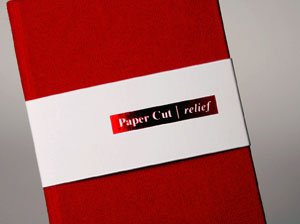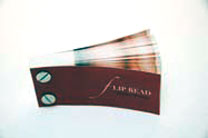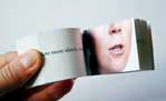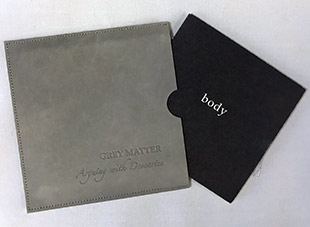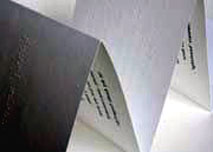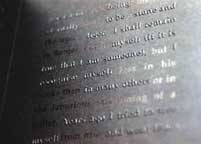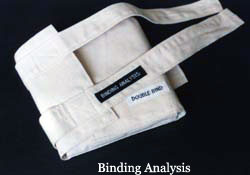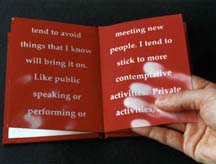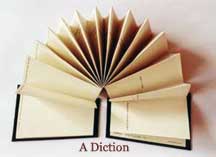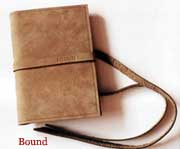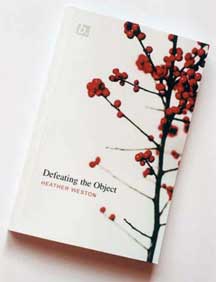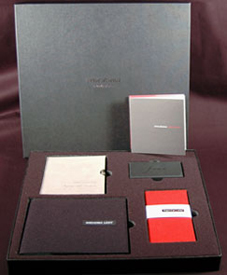
|
Heather Weston ~ England |
Share this page: |
| Interview with the Artist |
|
Paper Cut: relief 3 x 5.25"; 8 pages. Accordion structure bound into boards at end pages. Offset lithography on paper. Die cutting. Blind emboss title on front board. Bound in red book cloth on board enclosed by a white banderole with title. Once again, Weston transforms a complex psychological issue into the palpable reality of an artists' book. The subject is dark — self-harm — the experience is untidy and frustrating — as it should be. But if you have the patience, curiosity, and daring to see the experience through to the end — that is, to read the narrative — there is an uneasy sense of accomplishment, even hope. Heather Weston: "This book explores the complex subject of self-harm. Taking an issue that is both visually alarming and psychologically puzzling, the book engages with the experience of the powerless onlooker, as well as [with] the narrative of the self-harmer. Self-harm is often the result of extreme and chronic emotional isolation and is an increasingly common coping mechanism amongst young people, as a way of dealing with extremes of emotion. It involves a complex translation of emotional pain into its more tolerable physical equivalent. At the heart of the issue is a story that is felt to be intolerable but untellable. The pun in the title is a very serious one — the cut, ironically, provides the painkilling relief that is sought. The title, however, also alludes to the nature of the mark making within the book itself, which also involves the translation of emotional into physical. The book presents the cuts and scars of this translation within its pages, but leaves the solution, (the communication and thoughtful interaction that has remained so elusive), in the hands of the reader." |
|
Flip Read 1.5 x 3.75” flip book. Offset lithography. Paper covers with nickel binding screws. Laid in black paper box. Colophon information printed in interior of box. Explores the experience of lip reading. The book aims to challenge the hearing person's perceptions and assumptions about how we construct our verbal and visual world and how we make sense of the information available to us. It employs the naturally silent and yet verbal domain, as well as the variable pace that the reader can impose on the read, via the pace of the flick. The statement on the verso alludes to the idea that articulating words (in essence, turning the page more slowly) can aid in understanding (akin to a normal strategy of talking more loudly to a deaf person). The statement of the speaker is not revealed within the book, leaving a doubt in the reader's mind over whether they have understood as much as can be understood, reflecting the inexact science of lip reading. The actual spoken statement is this: "How would you cope with the volume turned off?" |
|
Grey Matter: 4.5 x 4.75"; 26 pages. Accordion fold with bound sections. Offset lithography, paper, book cloth and board in a gray leather slipcase. Titles embossed on slipcase. Explores the relationship between our bodies and minds within the context of the dominant philosophical paradigm: Descartes’ model of dualism, where the world is divided into polarized opposites - black and white, mind and body, right and wrong. The book structure is employed to question the validity of this extreme theoretical split so readily accepted within mainstream philosophical thought and theology. In creating a three way structure within the book, a middle ground is forged, articulating a different view point somewhere between black and white. Here subjectivity, perception and a far less certain view of the world allow for a "grey area" in which our minds and bodies can join up and represent the reality and complexity of a more holistic human condition. |
|
Shedding Light 5.5 x 6.75 "; 6 leaves. Offset lithography, blind debossing with felt cover. End pages slip into the felt cover so that it can be handled independently. Explores the book as a tactile object in the extreme and the importance of light and touch within the reading process. Taking away the book's usual visual narrative clues, the seeing reader is left with little traditional visual information with which to decode the presented 'text', but instead is faced with Braille text implicitly inviting them to feel the narrative. Help is provided in the form of a visual Braille alphabet card to assist readers to decipher the Braille and read the narrative that is hidden from conventional view. However, through a thorough physical exploration of the book, the reader may or may not discover a textual narrative on the reverse of the page. By shedding light through the page the book easily slips out of its felt cover and can be held up to the light, the sighted reader is given a textual translation of the Braille, emphasizing the need for light within the reading process. The ambiguous title relates to both the loss of light implied by the Braille, as well as the casting of light across the book needed for the text based reading. |
|
Borges & I 11 cm square. Clothbound concertina. Black text printed offset on black paper. Subtext in blind emboss. Clothbound concertina. Originally an edition of 20 copies, now available in an open edition. Once again, Heather Weston successfully navigates subtle psychological territory. This self-reflexive story explores the tension between Borges the writer and Borges the man. Weston magnifies that tension by drawing forth subtext from text, dramatizing the split between id and ego, deeper self and public persona. At the same time, the book functions as a metaphor for Borges' experience of going blind in middle age, a subject not directly alluded to in the story. But Weston interprets Borges' refusal to stop reading and writing as a possible cause of his blindness. Thus, both refusal and blindness are themselves symbolic of the split. Black text is printed offset on black paper, and Weston literally brings the subtext forward from Borges sentences by using blind embossing (raised letters). This gives a physical dimension to the page—with an obvious reference to Braille script—that interrupts and hijacks the prose of Borges the writer. The revealed subtext is a bitter and futile monologue, hewn from within the body of the original text. Insightful. |
|
Binding Analysis: Double Bind 15 cm x 14 cm x 2.5 cm. Double spiral bound at right and left edges. Pages split down the center. Bound in cloth wrapper. Padded rigid back panel. Heather Weston employs structure to say something about the experience of schizophrenia that text alone could not. The book is double spiral bound at right and left edges with the pages splitting down the center. Four separate narratives—one pictoral, two textual, one structural — unravel concurrently, and the reader must come to an understanding of and solve the riddle contained within the structure. Thus, the book refers directly to the process of psychoanalysis as a tool for understanding the book's story. A hidden narrative can only be pieced together when eight pairs of object images, which the binding naturally splits, are reunited and the pages flipped inside out—a reference to the necessity of an external person, the analyst/detective, who can take an active interest in the content. |
|
READ (past, tense) 4 x 4.75”; 16 pages. Handsewn in red cloth over boards. Cover title of raised and impressed letters, seen from below the surface of the cloth, extends the theme of text and subtext. Signed and numbered edition. This highly unusual artist's book uses heat-sensitive ink, that relies on the reader's inevitable contact with the page, to explore the ordinary and uncomfortable phenomenon of blushing. At first sight, the book contains a text that is reversed (white) out of red ink—like letters incised into a surface. But as the reader handles the book, the warmth from her fingers causes the ink to fade, revealing a private and intimate text, between the lines. The reader has to actually feel her way around the primary text, to get the full picture. Rationale gives way to inner dialogue. The calm, reasoned voice of, " I f I'm honest, I think I was put off by my rather disarming tendency to blush. At the slightest thing. I t always perplexed me," covers subconscious embarrassment: "Never do this again. Avoid this at all cost. Confusion and distress cloak themselves in shades of nonchalance. It's only a colour. I'm fine. Really." The interaction of the materials informs the process of reading and the unraveling narrative. |
|
A Diction Offset lithography on paper; book cloth on millboard. Printed on Gmund Bier paper made of recycled beer labels, pulp and beer fibers (hops, malt and yeast). Looks at the way we choose to deny our own realities through alcoholism, an addiction that perpetually allows us to disavow our difficulties with the world as we find it. The book reflects the never-ending cycle that is characteristic of any addiction, as the addict continually attempts to grapple with a reality which is uncomfortable and intolerable. What is favored by the addict is a short-term solution to long-term psychological discomfort at the expense of living in reality and working though the reality’s unpleasant aspects. The result is a repetitive reliance on a diction that controls and restricts what we perceive and feel as real. The book utilizes the page shape of a pint glass, and by doing this, the angled unfolding of the book’s monologue creates a full circle when open that carries the visual and structural metaphor of the cycle of addiction. |
|
Bound (dependence imposed) Offset lithography on paper; blind debossing; sewn nubuck. Achieving ‘separateness’ in infancy is one of the cornerstones of psychological development and relies on a firm adaptation to reality as presented through a healthy primary relationship (parent and child). Failure to achieve this can result in a debilitating range of psychological difficulties in later life. BOUND looks the structure of codependence and uses the single-section codex to explore the experience of psychological merger and separation. Central to this complex and private book is the concept of ‘imposition’ – how book pages are laid out and assembled for print – and its alternative meaning of ‘encroaching and burdening’. The book looks at what can go psychologically wrong within the parent-child relationship when the psychological reality that is imposed on the child is one of co-dependence. The result can be an eternal and binding dependence between parent and child which sets a pattern for all other relationships in the child’s later life. The two books within this piece have identical narratives, but each book is dependent on the other for its reading because of the way the imposition has been applied (onto a straight A4 sheet of text). The inappropriate imposition thus creates one text’s dependence upon the other. The two books are then bound within the same skin. The blind debossing of the impositional layout provides a visual key to unlocking the narrative held within the pages. The task of the reader is to discover the hidden narrative by understanding classic imposition. |
|
Defeating the Object Cover in digital four colour printing. Text in mono digital printing. Uses matt laminate. Perfect bound. This book explores the uncomfortable subject of suicide, the ultimate mal-adaptation to reality. In making a direct parallel between life and narrative, this book describes the baffling reality of a life cut short at the hand of its author. Taking as its starting point Freud’s writings in ‘Mourning and Melancholia’, it probes the shifting realities we encounter in extreme psychological circumstances: in this case, that of being in love, and of suicide. In both, we are subject to massive distortions of reality, and are temporarily or permanently overwhelmed by an external / internal object (person/thing) that is either to be enjoyed, or suffered. For the suicide, the ultimate solution is to do away with the oppressive internal object and so achieve a life on their own terms. Of course, a rather high price is paid in the achievement of these terms. A life for a life. The book takes the form of a traditional paperback novel and explores the issue of suicide through the fictitious life and death of its central character, an author. His narrative, along with his life, ends prematurely on page 28, and in this act he defeats both the internal and external object - life, the book, the father, himself. Implicit within the book is the notion of the creative legacy – perhaps the symbol of a life that cannot be lived in the flesh, but may instead be lived posthumously or variously through the artist’s creations. |
|
| Heather Weston SOLD titles: | |
Sense: Absence 13.25 x 12 x 1.5" black heavy cardboard box. Black foam lining with cutouts for four books. Includes ten-page accordion pamphlet (4.25 x 1.2") describing the collection and each book. Heather Weston: "A collection of bookworks — Flip Read, Grey Matter, Shedding Light, and Paper Cut — created in response to the complex and subjective experiences we process via our bodily senses. In the sensory overload encountered in contemporary life, it is not enough simply to experience these sensory moments, but instead it seems imperative to understand and challenge our reading of them." |
|
Page last update: 05.12.2022
Home | About Us | Contact Us | New Arrivals | Fine Press & Artists' Books | Broadsides |Resource Books | Order/Inquiry
Copyright © 2021 Vamp & Tramp, Booksellers, LLC. All rights reserved.
